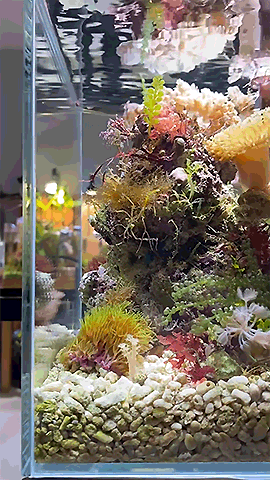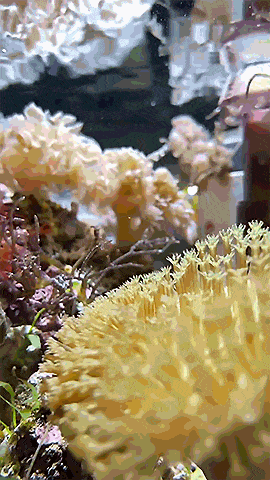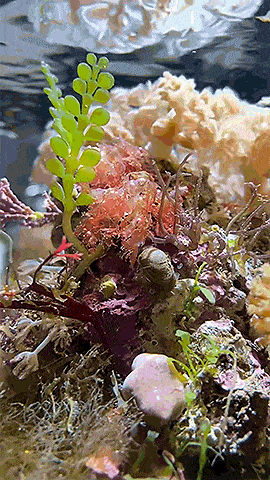#macroalgas
Explore tagged Tumblr posts
Text
Las macroalgas son fundamentales para la salud oceánica. Actúan como filtros de carbono, albergan fauna marina y regulan el ecosistema. Su desaparición impactaría directamente en la pesca y en el clima. México y Chile albergan grandes bosques de algas, hoy en riesgo por el calentamiento global y la extracción sin control.

0 notes
Text




Macroalgae tank ! ( source ! )

#ට#ignore the horrible quality jiji had to fight for their life for these to be under 10mb#stims#sensory#visual stim#stimblr#multicolor#green#brown#yellow#red#fish tank#aquarium#underwater#macroalgae#macro algae#algae#water#sea tag
220 notes
·
View notes
Text
I love you integrated multi trophic aquaculture <3
10 notes
·
View notes
Text



Summer seaweeds at Bean Hollow State Beach.
9 notes
·
View notes
Text
May I write words more naked than flesh, stronger than bone, more resilient than sinew, sensitive than nerve. ― Sappho
6 notes
·
View notes
Note
Just read your infodump on your favorite pokemon on.
I like the funny salt guy (nacli line)
You like the cool ghost plant
We are both whimsical 👍
I ALSO LOVE THE FUNNY SALT GUY I wasn't huge on Garganacl at first but then I was like wait this huge guy is a friend. We popping the biggest bottles in 50 years when gen 9 sitting cuties come out and I can have the polycule together

Also idk if you've heard of Cobblemon but I have never seen something look as at home as Naclstack in Minecraft. He lives there

2 notes
·
View notes
Text
I mostly write about organisms and not the principles of fishkeeping. However people often ask me about two related phenomena, cycling and stocking. Aquariums are safe for fish and other animals because of the nitrogen cycle. This is what determines, moreso than the water volume, the carrying capacity of the tank. But many people seem to be confused - what is the nitrogen cycle?
'Cycling' refers to the cycle by which the toxin ammonia, which is excreted as waste by organisms, before it is turned to nitrite and then to nitrate by biological actors. In aquarist parlance 'cycling' refers to the process and duration of time, during which the nitrogen cycle becomes established and stable. Properly the cycle continues throughout the operation of the aquarium.
Ammonia, which contains nitrogen, is the principal excretory product of living animals, and they void it because it is a toxic byproduct of their own metabolic processes. Human urination is an example of a way in which animals lose excess ammonia, but other kinds of animal may excrete ammonia by means of different methods.
Fortunately other organisms can find a positive use for ammonia, which animals don't want. Their own metabolisms create nitrite from the ammonia they intake, by breaking it down and adding oxygen to the nitrogen. Then yet more microscopic organisms convert the nitrite to the similarly named and chemically related nitrate, which must also be maintained at low levels, but is far less harmful. Traces of nitrate are in fact beneficial to some aquarium organisms.
The nitrogen cycle originates from the decomposition of amino acid, and this is why test kits are available to test for dissolved organics, which are not themselves inherently harmful, but their buildup indicates strain upon the system. How much strain is acceptable depends on the kinds of animals that are living in the aquarium. There isn't really a single standard as to when there are too many dissolved organics, or even nitrate. But regular and sensibly proportionate water changes, help to keep both under control.
Because it involves the processes of different organisms, the nitrogen cycle is very obviously an ecological, as well as a chemical phenomenon. Both the natural processes of the cycle, and the technology by which the effects of the benign organisms are maximised, are known as biological filtration, or biofiltration. It is different from physical and chemical filtration, although the functions of filter media may overlap.
The good bacteria that are involved, colonise available surfaces throughout the aquarium. They are present on rocks and on substrates such as sand and gravel. Similarly they colonise sponges and various proprietary items such as 'bio balls'. At this point, I wish to explain the introductory principles of biofiltration, not to cover its different expressions. It is however worth pointing out, the more the better.
Stocking levels are problematic principally because the living animals themselves create strains upon the biofiltration. Furthermore they require inputs of food, excesses of which contribute to dissolved organics, and therefore the nitrogen cycle, when they are uneaten - thus, messy feeders create more bioload than other organisms, lowering the carrying capacity of the aquarium system.
Feeding behaviors thus determine the 'footprint' animals have on the biofiltration in their aquarium, moreso than their size. It is also the mass of an animal that contributes to its output of wastes, moreso than any single dimension, such as its total length. Another determinant is the metabolic rate of the animal in question, which determines the speed at which its wastes are generated and churned out into the water.
The nitrogen cycle is also why overfeeding is bad, because excess food must inevitably decompose. By definition, the aquarist can't be overfeeding, from the perspective of the nitrogen cycle, when the supplied food is being eaten; overfeeding as in overeating is a different problem. However if feeding your livestock and keeping them healthy begins to stress the cycle, then you have too much bioload in your aquarium.
Often in marine aquariums, 'live rock' and 'live sand' are mentioned. These terms mystify many people, although they are relevant to filtration. The rocks and sand in question are substrates already colonised by microscopic organisms, as play a role in the nitrogen cycle. All items already this colonised are thus 'live' biofiltration media.
Unfortunately there is a misconception that 'live' rock needs transporting from the sea. Such rock is shipped damp but emersed, killing benign and desirable organisms, and necessitating a period called 'curing' in which photosynthesizers are denied an energy source, and further mortality and decomposition ensues. The result is that only 'tough as boots' organisms survive, and some of these species are harmful to corals and such.
Clearly despite the appeal of 'live rock' as a ready made, natural reef, it's use is problematic and self defeating. A distinction just be made, between the use of 'living' filtration media, and the importation of artificially depauperate microenvironments for aquariums. It is better to take rock and sand from an established reef tank instead, to avoid unwanted guests. Although even impoverished live rock can introduce interesting and useful 'friends', these can arrive also from established, nuisance-free tanks
A counterpart to the use of live rock and sand in reef aquariums, is the Walstad style of freshwater aquarium. The Walstad type of tank is one in which living plants and soil substrates are employed instead of artificial filtration; more common than a strict Walstad setup, is a hybrid system that employs both naturalistic and 'normal' approaches in its running.
Sometimes it is said that planted tanks do not cycle, or that adding plants stops the cycle. Nothing could be further from the truth. True aquatic plants and the organisms called algae, play a role in the cycle, which is why algae bloom during the cycling period of a new aquarium, when the lighting is switched on. Adding plants to freshwater tanks, and macroalgae to marine aquariums, should be thought of as assisting the stabilisation of the nitrogen cycle.
#nitrogen cycle#ammonia#nitrite#nitrate#biological filtration#biofiltration#stocking level#overfeeding#dissolved organics#live rock#live sand#algae#plants#Walstad method#planted tanks#macroalgae
2 notes
·
View notes
Text

A win for macroalgae, it seems my favourite genus laminaria convergently evolved on Kaminar
#with improvements in cgi i think there should be less planets in current trek shows that are obviously earth#discovery has some great visuals but i am begging for planets full of the type of stuff from the TOS botany lab#star trek#kaminar#saru#short treks#star trek discovery#macroalgae#laminaria#the brightest star
5 notes
·
View notes
Text

yall im literally going to explode, i haven’t had macroalgae in so long and this has awoken a hyperfixation beast in me
6 notes
·
View notes
Text
hi! marine bio major here. kelp is not a plant. hope that helps!

who let biologists play dnd
59K notes
·
View notes
Text
SciTech Chronicles. . . . . . . . .Mar 13th, 2025
#QNodeOS#programmable#independent#hardware#Paleolithic#vitamin-D#Ust'-Ishim#SF12#Habsburg#intermarriage#outcomes#inbreeding-coefficient#mikvah#menorah#Rome#well-dated#SuperCrudes#macroalgae#seaweed#standardized
0 notes
Text
autism aquarium special interest rambling feel free to scroll
think i might wanna set up my remaining empty 20 gallon as a saltwater tank perhaps. ive always thought of saltwater as outside of my budget/too difficult and complicated/needing about a hundred different pieces of equipment per tank and also dont love the neon blueish lighting which i thought was necessary for corals and such but lately ive been seeing people have success with really low-tech setups using incredibly basic filters and white led lighting and being able to have easy corals and macroalgae thriving like that so im kinda tempted. also it would be a chance to use the rest of the bag of instant ocean i bought when i was setting up a brackish jar for some opae ula (which are doing really well btw 👍 also i say jar but its i think like 3 gallons. not like tiny tiny)
#.pdf#rd#theres a few saltwater stores in town i might check em out and see the prices and what kinda fish/inverts/macroalgae they all have#i dont really know what id want to stock it with honestly it would be more of a macroalgae focused tank probably. underrated look imo#i know for sure that i dont want clownfish. just not really something that appeals to me personally#shrugs. will continue looking into it to see if this could be feasible for me perhaps
1 note
·
View note
Text
Las algas son plantas ¿o no?
Quizás es un tema que no te has detenido a pensar a menos que estés familiarizado con él, pero ¿son las algas plantas?. Es natural que pienses que sí; son organismos verdes, con aparentes hojas alargadas que crecen y se desarrollan en el mar, ¿hacen fotosíntesis además verdad?, ¿son plantas pero acuáticas, o no?. Pues no, si bien comparten ciertas similitudes y los límites entre plantas y algas…
#alga#algas#animalia#bacteria#biocombustibles#cadena trofica#cambio climatico#chromista#clorofila#especies#floracion algal#fondo marino#fotosintesis#fungi#macroalga#mar#marea#medio ambiente#microalga#microorganismo#microplasticos#naturaleza#organismos#plantas#plantas acuaticas#reinos biologicos#rio#super alimentos#vida acuatica
0 notes
Text
@genusniebla
the best macroalgae is by far the mermaids wineglass
12K notes
·
View notes
Text
Exploring the Potential of Macroalgae for Sustainable Crop Production in Agriculture
Citation: Prisa, D.; Fresco, R.; Jamal, A.; Saeed, M.F.; Spagnuolo, D. Exploring the Potential of Macroalgaefor Sustainable Crop Production in Agriculture. Life 2024, 14, 1263. https://doi.org/10.3390/life14101263 Link: https://www.mdpi.com/2075-1729/14/10/1263 Abstract: Marine macroalgae, which typically colonize coastal areas, are simple plant organisms. They live on rocks in coastal regions…
0 notes

